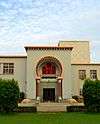Aligarh Movement
The Aligarh Movement was the push to establish a modern system of education for the Muslim population of British India, during the later decades of the 19th century.[1] The movement′s name derives from the fact that its core and origins lay in the city of Aligarh in Northern India and, in particular, with the foundation of the Mohammedan Anglo Oriental Collegiate School in 1875.[2] The founder of the oriental college, and the other educational institutions that developed from it, was Sir Syed Ahmad Khan. He became the leading light of the wider Aligarh Movement.
The educational reform established a base, and an impetus, for the wider Movement: an Indian Muslim renaissance that had a profound implications for the religion, the politics, the culture and society of the Indian sub-continent.
One of indirect consequences of the awakening is the notion that without this revival of a Muslim self-consciousness and self-confidence, directly attributable to the Movement, there could or would have been no Pakistan Movement in the run up to Indian Independence.
Education
Aligarh Muslim University is the creation of the movement. In 1886 Sir Syed Ahmad Khan founded the All India Muhammadan Educational Conference in order to promote more broadly the educational objectives of Aligarh Movement.[3]
The Aligarh Movement had a profound impact on the Indian society, particularly on the Muslim society compared to the other powerful but less adaptable movements of the 19th century. It influenced a number of other contemporary movements to a great extent that it caused the emergence of other socio-religious movements during the 19th century. The impact of Aligarh Movement was not confined to the Northern India only, but its expansion could be seen on the other regions of the Indian sub-continent during the 20th century.[4]
The Aligarh Movement was made a weighty and lasting contribution to the political emancipation of Indian Muslims.[5]
The movement was political in nature from the very beginning.[3] The Deoband school was opposed to the movement as Aligarh Movement was pro British.[6]
The Aligarh Movement introduced a new trend in Urdu literature. Sir Syed Ahmad Khan and his association left the old style of writing in the Urdu language, which was rhetorical and academic, and started a simple style which helped Muslims to understand the main purpose of the movement. Sir Syed Ahmed was the central figure behind this awakening..
The Aligarh Movement helped poets and writers to leave the romantic style of prose and poetry, and suggested the adoption of a moral, cultural, historical and political attitude which influenced the common life of the Indian Muslim.[7] Urdu Defence Association is regarded as an offshoot of the Aligarh Movement.
References
Notes
- ↑ "Sir Syed Ahmed Khan and the Aligarh Movement". YourArticleLibrary.com: The Next Generation Library. Retrieved 2016-04-03.
- ↑ "Syed Ahmad Khan and Aligarh Movement". Jagranjosh.com. Retrieved 2016-04-07.
- 1 2 Brass, Paul R. (2005-01-01). Language, Religion and Politics in North India. iUniverse. ISBN 9780595343942.
- ↑ "shodhganga.inflibnet.ac.in" (PDF). shodhganga. UGC.
- ↑ "ENLIGHTENMENT AND ISLAM: SAYYID AHMAD KHAN'S PLEA TO INDIAN MUSLIMS FOR REASON" (PDF). ZMO.
- ↑ Dasgupta, Jyotirindra; Studies, University of California, Berkeley Center for South and Southeast Asia (1970-01-01). Language Conflict and National Development: Group Politics and National Language Policy in India. University of California Press. ISBN 9780520015906.
- ↑ Gill, Dr Nazir M. (2013-01-11). Development of Urdu language and Literature Under the Shadow Of The British in India: Under the Shadow Of The British in India. Xlibris Corporation. ISBN 9781479757947.
Further reading
- Ashirbadi Lal Srivastava, The Aligarh movement; its origin and development, 1858-1906 by Ema. Esa Jaina( Book )
- Ashirbadi Lal Srivastava, Study on the movement of Indian Muslim regeneration established at Aligarh, India

